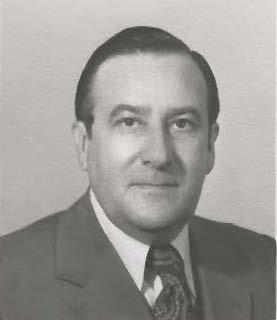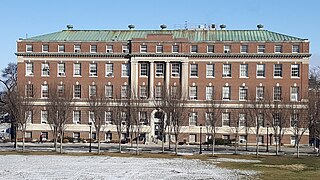
Titanium is a chemical element; it has symbol Ti and atomic number 22. Found in nature only as an oxide, it can be reduced to produce a lustrous transition metal with a silver color, low density, and high strength, resistant to corrosion in sea water, aqua regia, and chlorine.

Rensselaer Polytechnic Institute is a private research university in Troy, New York, with an additional campus in Hartford, Connecticut. A third campus in Groton, Connecticut, closed in 2018. RPI was established in 1824 by Stephen Van Rensselaer and Amos Eaton for the "application of science to the common purposes of life" and is the oldest technological university in the English-speaking world and the Western Hemisphere.
Refractory metals are a class of metals that are extraordinarily resistant to heat and wear. The expression is mostly used in the context of materials science, metallurgy and engineering. The definition of which elements belong to this group differs. The most common definition includes five elements: two of the fifth period and three of the sixth period. They all share some properties, including a melting point above 2000 °C and high hardness at room temperature. They are chemically inert and have a relatively high density. Their high melting points make powder metallurgy the method of choice for fabricating components from these metals. Some of their applications include tools to work metals at high temperatures, wire filaments, casting molds, and chemical reaction vessels in corrosive environments. Partly due to the high melting point, refractory metals are stable against creep deformation to very high temperatures.

Industrial processes are procedures involving chemical, physical, electrical, or mechanical steps to aid in the manufacturing of an item or items, usually carried out on a very large scale. Industrial processes are the key components of heavy industry.
Keith Dwight Millis was an American metallurgical engineer and inventor of ductile iron.
The Hunter process was the first industrial process to produce pure metallic titanium. It was invented in 1910 by Matthew A. Hunter, a chemist born in New Zealand who worked in the United States. The process involves reducing titanium tetrachloride (TiCl4) with sodium (Na) in a batch reactor with an inert atmosphere at a temperature of 1,000 °C. Dilute hydrochloric acid is then used to leach the salt from the product.
The Kroll process is a pyrometallurgical industrial process used to produce metallic titanium from titanium tetrachloride. The Kroll process replaced the Hunter process for almost all commercial production.
Carl Josef Bayer was an chemist from Austria-Hungary who invented the Bayer process of extracting alumina from bauxite, essential to this day to the economical production of aluminium.
Cornelius J. Barton is an American metallurgical engineer, businessman and the acting president of Rensselaer Polytechnic Institute from April 1998 until July 1999.
Palmer Chamberlain Ricketts was the ninth president of Rensselaer Polytechnic Institute. He served as president for 33 years and oversaw a period of major expansion and development of the university.

Richard Gilman Folsom was an American mechanical engineer, professor of mechanical engineering at the University of California at Berkeley, and the twelfth president of Rensselaer Polytechnic Institute. He also known as the 91st president of the American Society of Mechanical Engineers in the year 1972–73.

Wendell Earl Dunn Jr. was an American chemical engineer, metallurgist, and inventor. His technologies for high temperature chlorination, gold, tantalum and titanium extraction are still widely used.
Anatoly Ivanovich Belyaev (1906–1967) founded the school of metallurgy of light non-ferrous metals and semi-conducting materials. He was Professor of Moscow Institute of Steel and Alloys. He was head of the department of metallurgy of light metals in the Moscow Institute of Non-ferrous Metals and Gold from 1943 to 1963. From 1962 to 1967 he was organizer and head of the chair for producing pure metals and semi-conducting materials in MISIS.
Wah Chang Corporation was an American manufacturing company in the metal or alloy industry based in Albany, Oregon in the United States. Since 2014, it is a business unit of Allegheny Technologies and makes corrosion-resistant metals, such as hafnium, niobium, titanium, vanadium, and zirconium.
The history of Rensselaer Polytechnic Institute (RPI) spans nearly two hundred years beginning with its founding in 1824. RPI is the oldest continuously operating technological university in both the English-speaking world and the Americas. The Institute was the first to grant a civil engineering degree in the United States, in 1835. More recently, RPI also offered the first environmental engineering degree in the United States in 1961, and possibly the first ever undergraduate degree in video game design, in 2007.
The Hoopes process is a metallurgical process, used to obtain aluminium metal of very high purity. The process was patented by William Hoopes, a chemist of the Aluminum Company of America (ALCOA), in 1925.

Ricketts Building is a building that is home to the Department of Chemical and Biological Engineering at the Rensselaer Polytechnic Institute in Troy, New York. It is named for Palmer C. Ricketts, the ninth president of Rensselaer Polytechnic Institute. The building opened in 1935. It is currently used for labs, lectures, and some clubs.

Toru H. Okabe is a Japanese scientist specializing in materials science, environmental science, resource circulation engineering, and rare metals process engineering, particularly for electronic waste. His most recent work involves the advancement of new processing technology to recycle rare metals like niobium, titanium, yttrium, rhenium, neodymium, other lanthanides and precious metals. He is also involved in sustainable urban mining.







